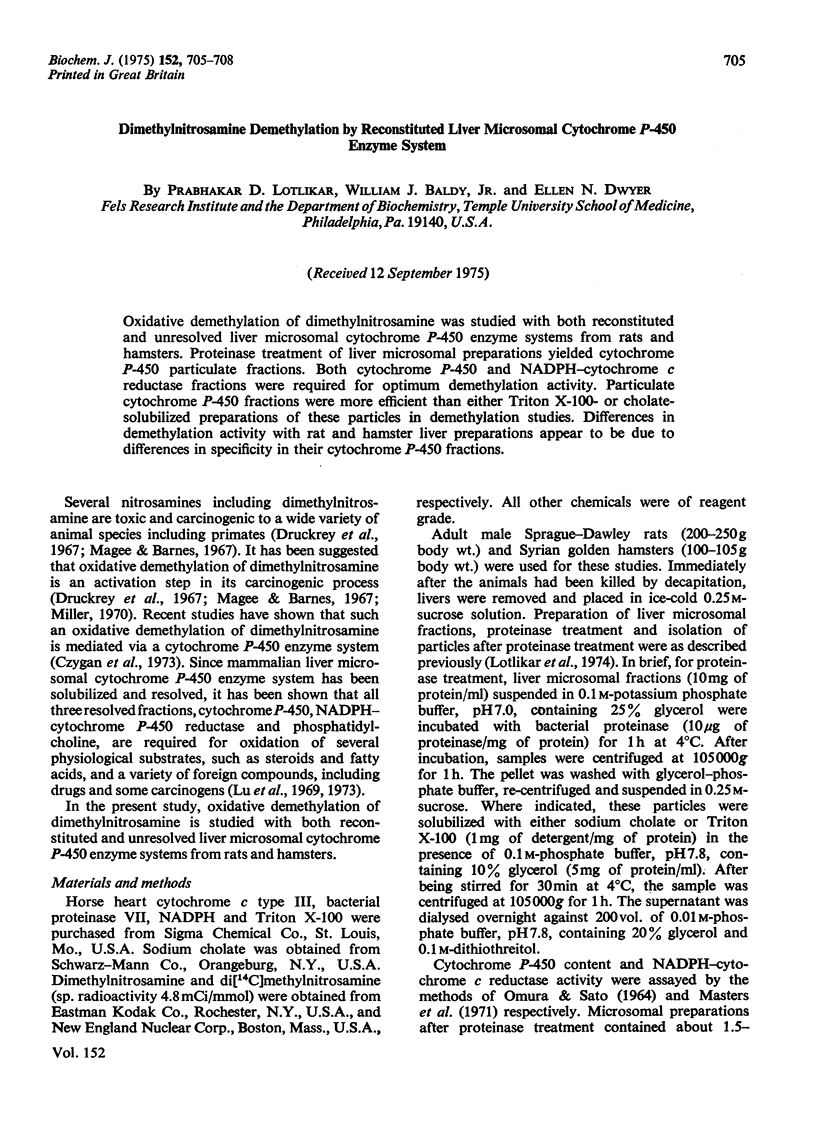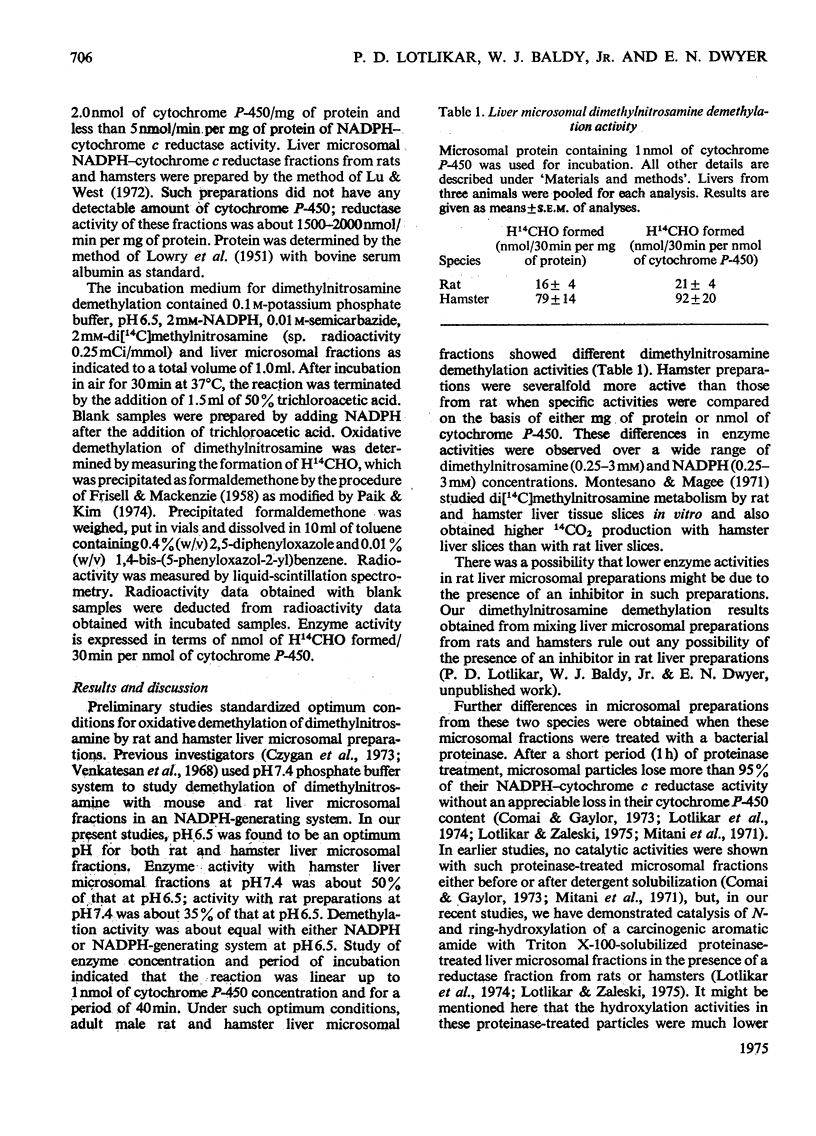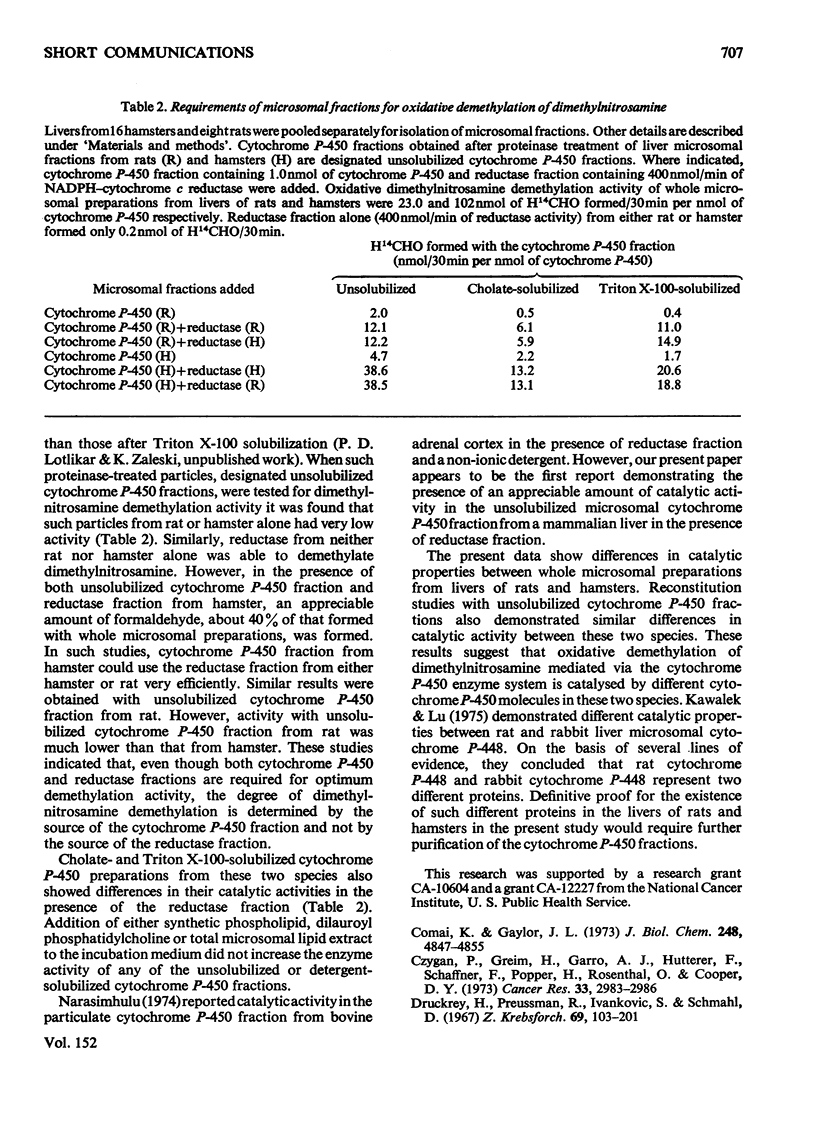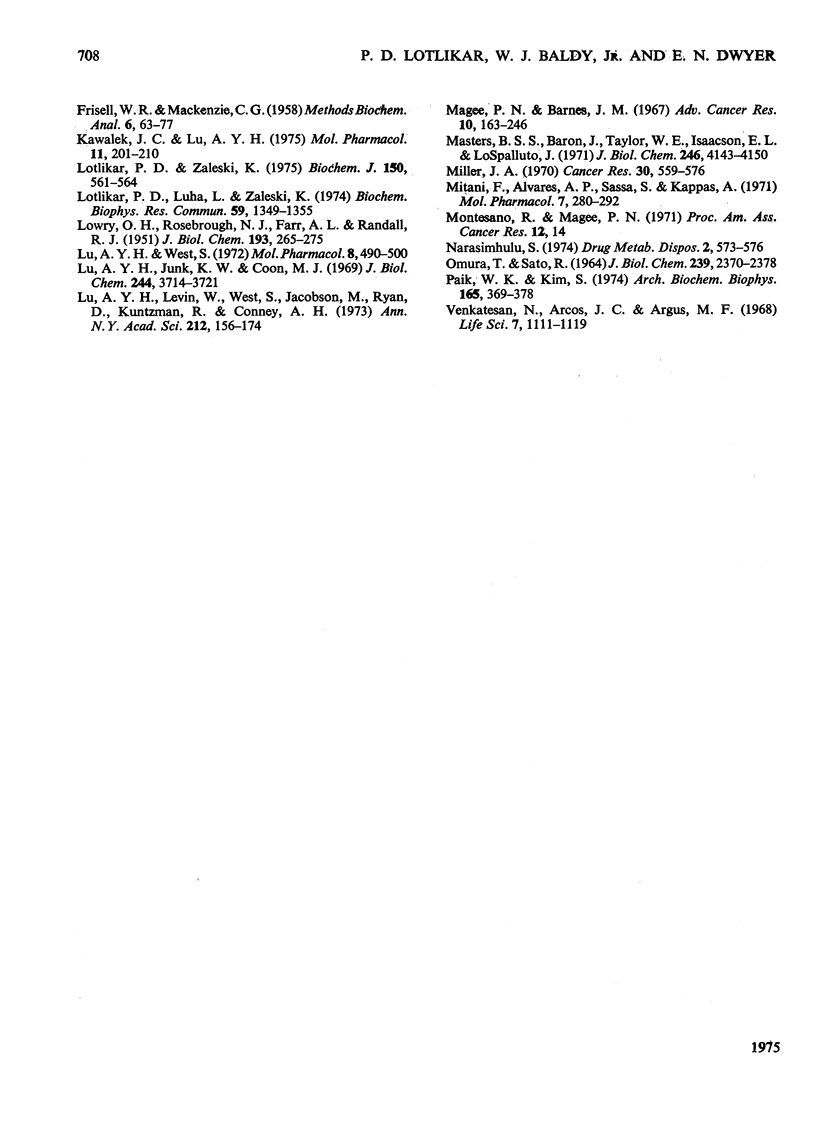Abstract
Oxidative demethylation of dimethylnitosamine was studied with both reconstituted and unresolved liver microsomal cytochrome P-450 enzyme systems from rats and hamsters. Proteinase treatment of liver microsomal preparations yielded cytochrome P-450 particulate fractions. Both cytochrome P-450 and NADPH- cytochrome c reductase fractions were required for optimum demethylation activity. Particulate cytochrome P-450 fractions were more effecient than either Triton X-100- or cholatesolubilized preparations of these particles in demethylation activity with rat and hamster liver preparations appear to be due to differences in specificity in their cytochrome P-450 fractions.
Full text
PDF



Selected References
These references are in PubMed. This may not be the complete list of references from this article.
- Czygan P., Greim H., Garro A. J., Hutterer F., Schaffner F., Popper H., Rosenthal O., Cooper D. Y. Microsomal metabolism of dimethylnitrosamine and the cytochrome P-450 dependency of its activation to a mutagen. Cancer Res. 1973 Nov;33(11):2983–2986. [PubMed] [Google Scholar]
- Druckrey H., Preussmann R., Ivankovic S., Schmähl D. Organotrope carcinogene Wirkungen bei 65 verschiedenen N-Nitroso-Verbindungen an BD-Ratten. Z Krebsforsch. 1967;69(2):103–201. [PubMed] [Google Scholar]
- FRISELL W. R., MACKENZIE C. G. The determination of formaldehyde and serine in biological systems. Methods Biochem Anal. 1958;6:63–77. doi: 10.1002/9780470110225.ch3. [DOI] [PubMed] [Google Scholar]
- Kawalek J. C., Lu A. Y. Reconstituted liver microsomal enzyme system that hydroxylates drugs, other foreign compounds, and endogenous substrates. VIII. Different catalytic activities of rabbit and rat cytochromes P-448. Mol Pharmacol. 1975 Mar;11(2):201–210. [PubMed] [Google Scholar]
- LOWRY O. H., ROSEBROUGH N. J., FARR A. L., RANDALL R. J. Protein measurement with the Folin phenol reagent. J Biol Chem. 1951 Nov;193(1):265–275. [PubMed] [Google Scholar]
- Lotlikar P. D., Luha L., Zaleski K. Reconstituted hamster liver microsomal enzyme system for N-hydroxylation of the carcinogen 2-acetylaminofluorene. Biochem Biophys Res Commun. 1974 Aug 19;59(4):1349–1355. doi: 10.1016/0006-291x(74)90462-8. [DOI] [PubMed] [Google Scholar]
- Lotlikar P. D., Zaleski K. Ring-andN-hydroxylation of 2-acetamidofluorene by rat liver reconstituted cytochrome P-450 enzyme system. Biochem J. 1975 Sep;150(3):561–564. doi: 10.1042/bj1500561. [DOI] [PMC free article] [PubMed] [Google Scholar]
- Lu A. Y., Junk K. W., Coon M. J. Resolution of the cytochrome P-450-containing omega-hydroxylation system of liver microsomes into three components. J Biol Chem. 1969 Jul 10;244(13):3714–3721. [PubMed] [Google Scholar]
- Lu A. Y., Levin W., West S., Jacobson M., Ryan D., Kuntzman R., Conney A. H. The role of cytochrome P-450 and P-448 in drug and steroid hydroxylations. Ann N Y Acad Sci. 1973;212:156–174. doi: 10.1111/j.1749-6632.1973.tb47594.x. [DOI] [PubMed] [Google Scholar]
- Lu A. Y., West S. B. Reconstituted liver microsomal enzyme system that hydroxylates drugs, other foreign compounds, and endogenous substrates. 3. Properties of the reconstituted 3,4-benzypyrene hydroxylase system. Mol Pharmacol. 1972 Sep;8(5):490–500. [PubMed] [Google Scholar]
- Magee P. N., Barnes J. M. Carcinogenic nitroso compounds. Adv Cancer Res. 1967;10:163–246. doi: 10.1016/s0065-230x(08)60079-2. [DOI] [PubMed] [Google Scholar]
- Masters B. S., Baron J., Taylor W. E., Isaacson E. L., LoSpalluto J. Immunochemical studies on electron transport chains involving cytochrome P-450. I. Effects of antibodies to pig liver microsomal reduced triphosphopyridine nucleotide-cytochrome c reductase and the non-heme iron protein from bovine adrenocortical mitochondria. J Biol Chem. 1971 Jul 10;246(13):4143–4150. [PubMed] [Google Scholar]
- Miller J. A. Carcinogenesis by chemicals: an overview--G. H. A. Clowes memorial lecture. Cancer Res. 1970 Mar;30(3):559–576. [PubMed] [Google Scholar]
- Mitani F., Alvares A. P., Sassa S., Kappas A. Preparation and properties of a solubilized form of cytochrome P-450 from chick embryo liver microsomes. Mol Pharmacol. 1971 May;7(3):280–292. [PubMed] [Google Scholar]
- Narasimhulu S. Partial resolution of the mixed-function oxidase system of bovine adrenocortical microsomes into two fractions in the absence of detergents. Drug Metab Dispos. 1974 Nov-Dec;2(6):573–576. [PubMed] [Google Scholar]
- OMURA T., SATO R. THE CARBON MONOXIDE-BINDING PIGMENT OF LIVER MICROSOMES. I. EVIDENCE FOR ITS HEMOPROTEIN NATURE. J Biol Chem. 1964 Jul;239:2370–2378. [PubMed] [Google Scholar]
- Paik W. K., Kim S. Epsilon-alkyllysinase. New assay method, purification, and biological significance. Arch Biochem Biophys. 1974 Nov;165(1):369–378. doi: 10.1016/0003-9861(74)90175-1. [DOI] [PubMed] [Google Scholar]
- Venkatesan N., Arcos J. C., Argus M. F. Differential effect of polycyclic hydrocarbons on the demethylation of the carcinogen dimethylnitrosamine by rat tissues. Life Sci. 1968 Oct 1;7(19):1111–1119. doi: 10.1016/0024-3205(68)90217-8. [DOI] [PubMed] [Google Scholar]


